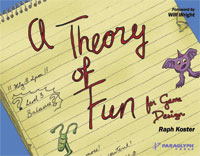We can take some good points about fun from this thread already. Putting it has a theory is something i would never do, because, well, it would loose its fun. ;D
Some guidelines we can follow (many taken from these same thread). We don’t have to follow them all or follow them at all to build a good game, it’s just guidelines and what works for some games will not work for others and vice-versa:
Complexity - the more complex the game the more the potential fun that can be taken from it
Chalenge - a bigger chalenge also increases the fun potential
Replayability - if when you play it again it offers a sligtly different experience, this is also a potential for more fun
Immersion - how good is the illusion of reality
Accessibilty - the game doesn’t need an Einstein to use it and follow it, If the player is stuck on an hard part of the game it won’t stop him from continuing to play the game
Linearity - too much linearity can kill a game
Learning Curve - A soft learning curve appears to be a good thing
Continuity - The game follows logicaly and intuitively from the players actions, also potentialy better
Innovation - The more original the better
Identification - The player identifies himself with its avatar
Beliavable - The emotions transmited by npcs are beliavable, even if its just a small game with bitmap chars, even three little characters like this :*) can transmit an emotion
Stimulus/Reward - The game stimulates the player and gives him a reward for his curiosity, later the player develops a response to stimulus
Variety/Repetition - Don’t present allways the same info, hints, dialogs, situations in the same way. Information can be given by images, situations the player watches, dialog, even the architecture of a city or the layout of a room. On the other side repetition can be important in creating the right feeling if well used.
Ambience - Games that are concistent in creating a certain ambient or the feeling of “something in the air” have more potential to be fun.
There’s probably more than this. But, i repeat, these are only guidelines. I can remenber of many great games that didn’t follow many of these guidlenes.




